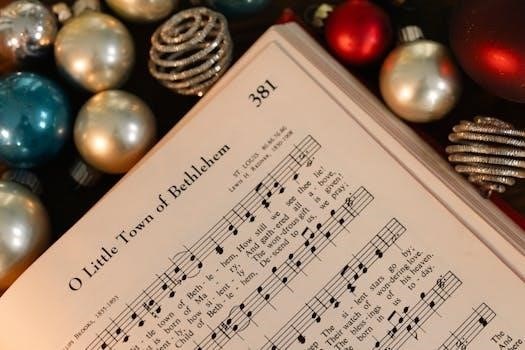This timeless Advent hymn, deeply rooted in tradition, encapsulates the anticipation of Christ’s arrival․ Its powerful lyrics and resonant melody evoke a sense of longing for redemption and peace․ The hymn’s enduring popularity makes it a staple during Advent․
Hymn’s Significance and Context
“O Come, O Come Emmanuel” holds immense significance within the Christian liturgical calendar, particularly during the Advent season․ Serving as a profound expression of longing and anticipation, it reflects the spiritual yearning for the Messiah’s coming․ The hymn’s context is deeply intertwined with Old Testament prophecies and the historical narrative of Israel’s captivity․ Its lyrics articulate the hope for deliverance from oppression and the arrival of a savior who will bring justice and peace․ The hymn’s use in Advent services underscores the themes of preparation, repentance, and the expectation of Christ’s birth․ It bridges the gap between the ancient prophecies and the Christian belief in Jesus as the fulfillment of those prophecies․ Furthermore, it creates a shared experience of hope and longing among believers․ It also connects the present to both the past and the future․

Historical Background of the Hymn
The hymn’s history traces back to Latin antiphons from the medieval era․ These ancient texts formed the foundation for the familiar verses known today․ The melody also has medieval roots, giving it a rich, historical feel․
Latin Origins and Medieval Roots
The hymn “O Come, O Come, Emmanuel” has its origins deeply embedded in the rich tapestry of medieval liturgical tradition․ Specifically, the hymn’s textual foundation lies in the “Great O Antiphons,” a set of seven chants traditionally sung during the week leading up to Christmas within the Roman Catholic Church․ These antiphons, each beginning with “O,” invoke various Messianic titles derived from Old Testament prophecies, such as “O Sapientia” (O Wisdom), “O Adonai” (O Lord), and “O Radix Jesse” (O Root of Jesse), among others․ These texts were originally intended to frame the Magnificat canticle during Vespers, a practice dating back centuries․ “O Come, O Come, Emmanuel” is a compilation of these antiphons, expressing a yearning for the coming of the Messiah․ The hymn’s roots in these ancient chants give it a profound sense of history and spiritual depth, connecting modern-day worshippers to the long-standing tradition of Advent anticipation․ The Latin text, “Veni, veni Emmanuel,” reflects its medieval origins․
John Mason Neale’s Translation
The English rendition of “O Come, O Come, Emmanuel,” widely sung today, is largely attributed to the work of John Mason Neale, a 19th-century Anglican priest, scholar, and hymn writer․ Neale’s translation, published in 1851, skillfully transformed the ancient Latin text into a poetic and accessible form for English-speaking congregations․ He masterfully preserved the theological depth and longing of the original antiphons, while adapting them to the cadence and sensibilities of the English language․ Neale’s version is not a literal, word-for-word translation, but rather a creative interpretation that captures the spirit and meaning of the Latin․ He carefully selected words and phrases that conveyed the anticipation and hope inherent in the Advent season․ Neale’s contribution has been instrumental in popularizing the hymn, which is due to his sensitive and thoughtful approach․ His work ensured the hymn’s place in the English hymnal canon, allowing it to resonate with countless worshippers․ Neale’s translation remains the definitive version for many․

Lyrical Analysis of “O Come, O Come Emmanuel”
The hymn’s lyrics explore themes of captivity, exile, and the fervent desire for redemption through the coming of Emmanuel․ The verses are rich with biblical allusions and symbolic language․
Thematic Overview⁚ Captivity and Redemption
The core of “O Come, O Come Emmanuel” lies in its poignant depiction of a people yearning for liberation․ The hymn speaks of a “captive Israel,” a powerful image representing not just historical exile, but also the spiritual bondage of humanity․ This captivity is portrayed as a state of “lonely exile,” emphasizing the deep sense of separation and longing for divine intervention․ The repeated plea for Emmanuel to “ransom captive Israel” highlights the central theme of redemption․ This is not merely a physical release, but a profound spiritual rescue from the depths of despair․ The hymn expresses a desperate hope for liberation, with the expectation that the “Son of God” will appear to break the chains of captivity and bring about a new era of freedom and peace․ This overarching theme of captivity and the promise of redemption resonates deeply with the Advent season’s focus on anticipating Christ’s coming․
Key Biblical References⁚ Jesse, David, and Emmanuel
The hymn “O Come, O Come Emmanuel” is rich with biblical allusions, drawing heavily from Old Testament prophecies․ The “Rod of Jesse” refers to the lineage of Jesus, stemming from Jesse, the father of King David, underscoring Jesus’s royal heritage․ The “Key of David” further emphasizes this connection, signifying Jesus’s authority and power to open the way to salvation․ These references highlight Jesus’s role as the promised Messiah․ The most significant reference is “Emmanuel,” a name meaning “God with us,” which is central to the hymn’s theme․ This name directly links to the prophecy in Isaiah that a virgin will conceive and bear a son, and they shall call his name Emmanuel․ The hymn’s use of these biblical references underscores its theological depth, firmly grounding its plea for redemption in scripture, and reinforcing the hope for the coming of the promised savior․

Musical Aspects of the Hymn
The hymn’s melody, often described as haunting and ancient, contributes to its evocative power․ Its modal nature and somber tone reflect the longing for Christ’s coming․ The music enhances the lyrics, creating a deeply moving experience․
Traditional Melody and Variations
The traditional melody of “O Come, O Come Emmanuel” is a 15th-century French processional tune, often referred to as “Veni Emmanuel․” This melody is characterized by its modal structure, giving it a distinct medieval sound that resonates with the hymn’s ancient themes․ The tune’s simplicity and solemnity contribute to its power to evoke a sense of longing and anticipation․ Over the centuries, various arrangements and variations of this melody have emerged, adapting it for different settings and musical styles․ These variations often involve changes in harmony, instrumentation, and tempo, yet the core melody remains recognizable and retains its distinctive character․ Despite the alterations, the fundamental essence of the traditional melody is preserved․ These diverse interpretations reflect the hymn’s enduring appeal and adaptability across different musical traditions․ The melody’s haunting quality makes it a perfect vehicle for the yearning expressed in the text, adding to the hymn’s deep emotional impact․
Use of Refrain and its Purpose
The refrain, “Rejoice! Rejoice! Emmanuel shall come to thee, O Israel,” serves as a powerful and unifying element within “O Come, O Come Emmanuel․” This recurring line punctuates each verse, shifting the focus from lament and longing to the hopeful promise of Christ’s arrival․ The refrain acts as a reminder of the ultimate purpose behind the yearning expressed in the verses․ It provides a consistent message of joyful anticipation amidst the themes of captivity and exile․ Its repetition creates a sense of building expectation and reinforces the central theological theme of redemption․ The refrain also invites congregational participation, fostering a communal experience of hope and faith․ The use of the imperative “Rejoice!” is not merely a suggestion, but a call to action, urging believers to actively embrace the promise of Emmanuel’s coming․ It serves as a beacon of light within the solemnity of the hymn, emphasizing that the anticipation is not in vain․

“O Come, O Come Emmanuel” in Modern Culture
The hymn continues to be a beloved part of Advent, with numerous contemporary arrangements enhancing its reach․ It appears in various musical styles, reflecting its timeless appeal and enduring relevance across diverse traditions․
Contemporary Arrangements and Performances
“O Come, O Come Emmanuel” has seen a remarkable resurgence in modern times, with artists across various genres offering unique interpretations․ These contemporary arrangements often blend the traditional melody with new harmonies and instrumental textures, appealing to a broad audience․ From soulful renditions by artists like for KING & COUNTRY and Needtobreathe, to classical adaptations featuring orchestral arrangements, the hymn’s versatility shines through․ Many modern versions incorporate elements of pop, rock, and even electronic music, demonstrating the timeless message’s ability to resonate across musical styles․ These diverse performances have helped introduce the hymn to new generations, ensuring its continued relevance in modern culture․ The availability of sheet music and lyrics online, including in PDF format, further facilitates its widespread adoption in various settings, from churches to personal performances․ This adaptability underscores the hymn’s lasting impact and its ability to connect with diverse audiences through varied musical expressions․
Hymn’s Role in Advent Celebrations
“O Come, O Come Emmanuel” holds a central place in Advent celebrations, serving as a powerful expression of the season’s themes of waiting and anticipation․ Its lyrics, which draw on Old Testament prophecies, encapsulate the longing for the Messiah’s arrival․ The hymn is frequently sung during church services, acting as a focal point for reflection on the hope of redemption․ Its inclusion in Advent calendars and other devotional materials further underscores its significance during this time․ The hymn’s message of longing for peace and salvation resonates deeply with the spiritual preparation that defines Advent․ Its repeated refrain, “Rejoice! Rejoice! Emmanuel shall come to thee, O Israel,” serves as a reminder of the ultimate fulfillment of these prophecies․ The widespread availability of the hymn’s lyrics, often in downloadable PDF formats, ensures its accessibility to congregations and individuals alike, strengthening its role in Advent rituals and observances․ It invites active participation in the season’s reflective mood․

